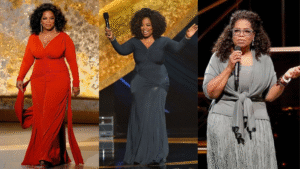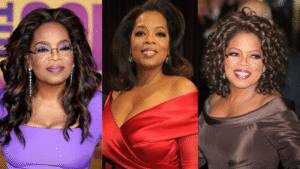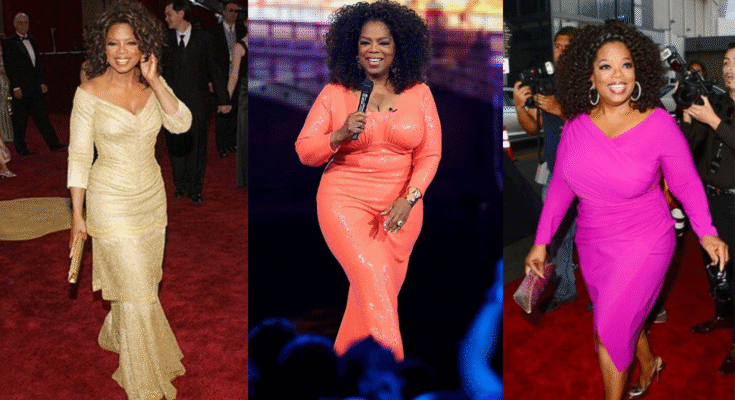The Heart Behind the Icon: Meet Oprah
In a small, segregated town in rural Mississippi, a baby girl was born to an unmarried teenage mother. Nobody predicted this child—born into crushing poverty, racial discrimination, and unspeakable trauma—would one day become the most powerful woman on television and reshape the media landscape forever.
Her name was Oprah Gail Winfrey. And her story is the most improbable American dream ever told.
How a Traumatized Child from Poverty Became a Global Icon
The Darkness Before the Light: Growing Up in Unimaginable Circumstances
January 29, 1954 – Oprah was born in Kosciusko, Mississippi, to Vernita Lee, a teenage maid, and Vernon Winfrey, a soldier who wasn’t present for her childhood. From her first breath, the odds were stacked impossibly against her.
Her mother didn’t want a child. The relationship with her father was non-existent. Oprah was born during the Jim Crow era—a time when being Black in the American South meant living under systematic oppression, racial violence, and dehumanization.
Living in Desperation: The Severity Nobody Talks About
In her earliest years, Oprah experienced poverty so severe it shaped her entire being:
The Physical Poverty:
Living in a one-room shack with no electricity
Sleeping on dirt floors
Wearing dresses made from potato sacks
Going to bed hungry night after night
No access to clean water or basic sanitation
The Emotional Devastation:
Rejected by her mother, who worked long hours and showed little affection
Raised by her grandmother, Hattie Mae, in the deepest rural Mississippi
Understanding at age 6 that she was “different” and “unwanted”
Witnessing racial discrimination daily—being told she was less than because of her skin color
The Unspeakable Trauma: Silence and Shame
At age nine years old, Oprah suffered sexual abuse—a trauma so profound that she carried the shame and silence for decades. This wasn’t a single incident; this was systemic, predatory exploitation of a vulnerable child.
Shortly after, at age fourteen, Oprah became pregnant from rape. She gave birth to a premature son who died days later. A teenager, a rape victim, a grieving mother—and the world would never know her name.
Yet she survived.
Against All Odds: The School That Changed Everything
Despite everything—the poverty, the abuse, the trauma, the shame—Oprah found refuge in one place: school.
Her teacher, Eugene Braxton, recognized something in this quiet, traumatized girl. He saw her potential beneath the scars. He encouraged her, invested in her, and told her she was capable of extraordinary things.
For the first time in her life, someone believed in her.
School became her escape. Education became her weapon against despair. Oprah threw herself into her studies, debate, and public speaking—transforming the pain into purpose.
The Invisible Years: Rising from Ashes to Opportunity
High School Excellence: The Beginning of Transformation
By high school, Oprah had begun to transform herself. She:
Excelled academically
Won speech and debate competitions
Became involved in theater and public speaking
Changed her name from “Orpah” to “Oprah” (inspired by a biblical character)
Winning scholarships and academic honors, Oprah was determined to escape her circumstances. But the path from rural Mississippi poverty to success wasn’t straightforward.
College and the Miss Black America Journey
Oprah attended Tennessee State University, one of the few available pathways for a Black girl from poverty in the 1970s. She majored in drama and speech, continuing to build the skills that would eventually define her.
During college, Oprah won Miss Black America 1971—her first major recognition. This wasn’t just a beauty pageant victory; it was validation that she had something to offer the world.
More importantly, the scholarship from the pageant paid for her education, literally freeing her from poverty.
Early Broadcasting: Starting at the Bottom
After college, Oprah pursued her dream: broadcasting. But the industry wasn’t ready for her.
The Barriers She Faced:
Being a woman in a male-dominated industry
Being Black during an era of subtle (and not-so-subtle) racism
Being told she was “too Black,” “too fat,” “too Southern,” and “too emotional” to be on television
Station managers suggesting she change her appearance, accent, and personality
Being paid a fraction of what white male anchors earned
The Rejections:
Fired from her first television job in Baltimore for being “too emotional” and “too personally involved” with stories
Told repeatedly that she would never succeed in broadcasting
Watching less qualified, less talented people advance while she was overlooked
But Oprah was no stranger to adversity. She had survived far worse.
The Talk Show Experiment: Baltimore, 1978-1983
In 1978, Oprah got a breakthrough opportunity. WJZ-TV in Baltimore hired her to host a local morning talk show called “People Are Talking.”
This wasn’t primetime. This wasn’t national television. This was local Baltimore broadcasting with minimal resources and low expectations.
But Oprah transformed it.
She brought something revolutionary to television: authenticity. Instead of reading scripts robotically, she had genuine conversations. Instead of maintaining emotional distance, she connected with guests on a human level. Instead of pretending to be someone else, she was unapologetically herself.
The Results Were Stunning:
Local ratings skyrocketed
Viewers connected with her authenticity
The show became Baltimore’s #1 talk show
Oprah went from being considered a failed news anchor to a breakout talent
For the first time, her “flaws”—her emotionality, her empathy, her personal investment in stories—became her greatest assets.
The Breakthrough: When the World Finally Noticed
Chicago, 1984: The Moment Everything Changed
In 1984, ABC Chicago offered Oprah an opportunity to host a struggling local talk show called “A.M. Chicago.” It was a morning slot. It was local. It had failing ratings.
Nobody predicted it would change television forever.
Oprah brought the same authenticity, warmth, and genuine human connection she’d developed in Baltimore. Within months:
“A.M. Chicago” beat the nationally syndicated “Donahue Show” in the same time slot
Local ratings tripled
Viewers became obsessed with this warm, authentic, relatable woman on their screens
ABC executives realized they had something extraordinary
The National Explosion: “The Oprah Winfrey Show” (1986-2011)
In 1986, Oprah’s show went national. What followed was unprecedented in television history:
The Numbers That Tell the Story:
At peak: Watched by over 49 million viewers weekly in 145 countries
Emmy Awards: Multiple wins and nominations
Syndication: One of the most successful syndicated programs ever
25 years: The show ran for 25 seasons, becoming a cultural institution
Why She Dominated:
She didn’t just interview guests—she had conversations with them
She asked the questions viewers wanted answered

She created a safe space for people to share their deepest stories
She connected celebrity culture with real human experience
She was genuinely interested in people’s lives, not just headlines
The Cultural Impact:
Oprah became a household name globally
Her book club recommendations became instant bestsellers
Interview techniques defined modern broadcasting
She transformed the talk show from entertainment into cultural moment
Building an Empire: From Talent to Mogul
The Media Dominance: Building a Company
While most talk show hosts were content to be on-air talent, Oprah had bigger vision. She wanted to own her work, control her narrative, and build wealth that would never be taken away.
Harpo Productions
Founded her own production company in 1986
Produced “The Oprah Winfrey Show” and other content
Maintained creative control over her projects
Later expanded to produce films, documentaries, and streaming content
The Money Moves: From Employee to Billionaire
Ownership Changed Everything:
Unlike employed talk show hosts, Oprah owned her show
She negotiated syndication deals that made her extraordinarily wealthy
By the 1990s, she was earning $125+ million annually
She became a producer, not just a performer
Strategic Investments:
OWN (Oprah Winfrey Network): Her own cable network launched in 2011
Magazine: “O, The Oprah Magazine” became a highly successful publication
Book Club: Her recommendations became cultural events
Streaming Content: Original programming for Apple TV+, Netflix, and others
Real Estate: Luxury properties portfolio worth hundreds of millions
The Business Results:
MetricBefore OwnershipAfter Ownership
Annual Income
~$1-2 million
$125+ million
Net Worth
Modest
$2.8+ billion
Control
Employees
Owner and Executive Producer
Influence
National
Global
Impact
Entertainment
Cultural Institution
More Than Business: The Philanthropic Force
Using Wealth for Purpose: Giving Back
Oprah’s wealth could have made her just another billionaire. Instead, she became one of the world’s most generous philanthropists.
Education:
Donated over $100 million to educational institutions
Established the Oprah Winfrey Foundation focused on education and empowerment
Created scholarships for thousands of deserving students
Built schools in South Africa to provide education to underprivileged children
Women’s Empowerment:
Created programs to lift women out of poverty
Supported domestic violence survivors
Funded girls’ education globally
Established mentorship programs for young women
Healthcare and Social Justice:
Donated to hospitals and medical research
Supported racial justice initiatives
Funded environmental causes
Advocated for systematic change, not just charity
The Numbers:
Over $400+ million in charitable giving
Helped transform lives of millions globally
Used her platform to raise awareness for critical issues
The Secret Behind Oprah’s Unstoppable Rise
Lesson 1: Authenticity Defeats Artifice
Oprah succeeded not by being what others wanted her to be, but by being genuinely herself. In an industry built on facades and performance, her authenticity was revolutionary.
When managers told her to be less emotional, she became more emotionally available. When they said to be less personal, she became more vulnerably human. Her “flaws” became her superpowers.
Lesson 2: Empathy Is a Superpower
Growing up traumatized and poor, Oprah developed extraordinary empathy. She could sense pain in others because she’d survived her own. This empathy wasn’t performance—it was genuine human recognition.
Her ability to make people feel seen, heard, and valued became her greatest professional asset.
Lesson 3: Education Is the Ultimate Freedom
Oprah never forgot that education saved her. She invested in her own education relentlessly, and she’s spent billions ensuring others have access to the same liberating tool.
She understood what books, teachers, and learning opportunities did for her traumatized child—they gave her hope.
Lesson 4: Ownership Equals Power
Instead of being employed by networks, Oprah built her own company. This shift from employee to owner changed everything. It’s the difference between earning a salary and building wealth. Between following someone else’s vision and creating your own.
Lesson 5: Turning Pain Into Purpose
Oprah didn’t hide her trauma. She transformed it. Her experiences of poverty, racism, abuse, and loss informed everything she did. She became an advocate for the voiceless because she had been voiceless.
Her pain became the source of her purpose.
The Global Icon: Impact Beyond Numbers
Reshaping Television and Media

Oprah fundamentally changed what television could be:
Proved that authentic, vulnerable conversation could compete with entertainment
Showed that a Black woman could dominate media in a racist industry
Demonstrated that talking about real issues could attract massive audiences
Created a new model for talk show broadcasting that still dominates today
Cultural and Social Impact
Race and Representation:
First Black woman to host a major talk show
Challenged racist stereotypes through her presence and work
Became a symbol of Black excellence and achievement
Used her platform to advance racial justice
Gender and Empowerment:
Proved women could run billion-dollar enterprises
Became a role model for female entrepreneurs
Advocated for women’s rights and equality
Mentored countless women in media and business
Mental Health and Vulnerability:
Normalized discussing trauma and abuse
Created space for vulnerable conversation on mainstream television
Encouraged people to seek help and healing
Reduced stigma around mental health
The Journey: Before & After
AspectThe Traumatized Child (1954-1975)The Global Icon (1986-Present)
Housing
One-room shack with dirt floors
Luxury estates worldwide
Food Security
Went hungry regularly
Billionaire with resources for millions
Safety
Victim of abuse and assault
Built support systems for survivors
Opportunity
None visible
Created opportunities for others
Income
Extreme poverty
$125+ million annually at peak
Influence
Voiceless
Heard by billions
Purpose
Survival
Transforming lives globally
Financial Net Worth
$0, facing debt
$2.8+ billion
Control
None over circumstances
Owner of media empire
What Makes Oprah Different: The Essence
Not Just Successful—Transformative
Oprah didn’t just become rich and famous. She became a force for social change. She didn’t just build a company; she built a legacy.
From Victim to Victor to Visionary
Her journey wasn’t just overcoming circumstances—it was transforming trauma into purpose. The very experiences that could have destroyed her became the foundation of her mission to help others heal.
The Living Proof
Oprah Winfrey is living proof that:
Your beginning doesn’t determine your ending
Trauma can be transformed into purpose
Authenticity is more powerful than perfection
Empathy can be your competitive advantage
Ownership creates generational wealth
Your story can become a message that changes the world
The Bottom Line: Why Oprah’s Story Matters
That poor girl from rural Mississippi—sexually abused, racially oppressed, economically devastated—didn’t just survive. She didn’t just succeed.
She became a billionaire philanthropist who has transformed millions of lives.
She didn’t do it by being what others expected. She did it by being authentically, courageously herself. She didn’t do it by hiding her trauma. She did it by transforming her pain into purpose.
Today, when a young girl growing up in poverty or trauma watches Oprah’s story, she doesn’t see someone “lucky.” She sees someone who chose to rise despite everything telling her to stay down.
She sees a mirror of her own potential.
Key Takeaways for Believers in Transformation
🌟 Your past circumstances don’t define your future potential 🌟 Trauma survived becomes wisdom shared 🌟 Authenticity in a fake world is revolutionary 🌟 Empathy for others’ pain connects you to their hearts 🌟 Education is the ultimate path to freedom 🌟 Ownership creates generational wealth and control 🌟 Your story of struggle can inspire millions 🌟 Giving back multiplies the blessing of success 🌟 One person’s transformation can reshape an entire industry 🌟 Vision + Authenticity + Persistence = Unstoppable Impact
Oprah’s Words That Define Her
“Turn your wounds into wisdom. You will do the best you can with what you know. But once you know better, you do better.”
“The biggest adventure you can take is to live the life of your dreams.”
“You get in life what you have the courage to ask for.”
The Continuing Legacy
Oprah didn’t retire when she ended her talk show in 2011. She expanded:
Launched OWN network to continue influencing media
Created original programming with streaming giants
Continued philanthropic work globally
Mentored a new generation of media creators
Remained an advocate for justice and empowerment
At every stage of her life, from traumatized child to talk show host to billionaire mogul, Oprah has demonstrated that your origins don’t have to be your destiny.
That poor girl from Mississippi? She’s still here. She’s still fighting. She’s still transforming lives.
And the world will never be the same.



